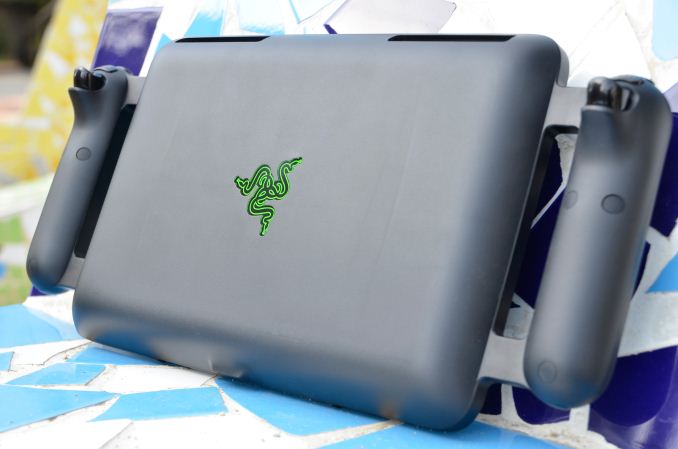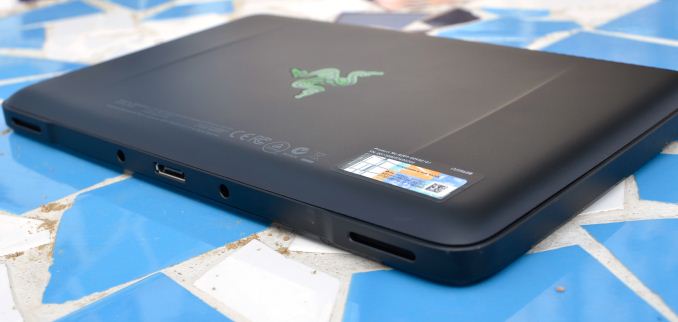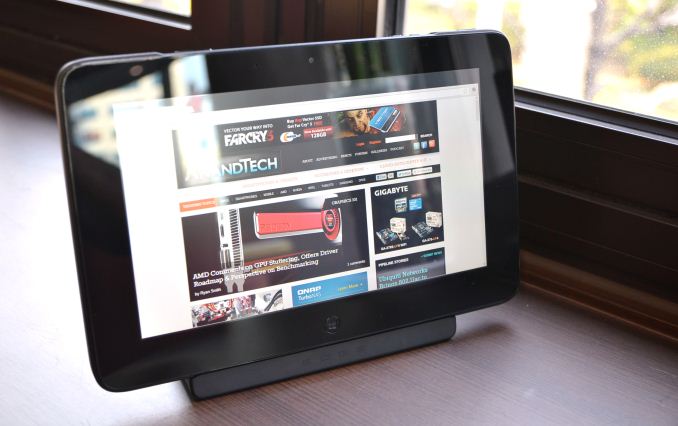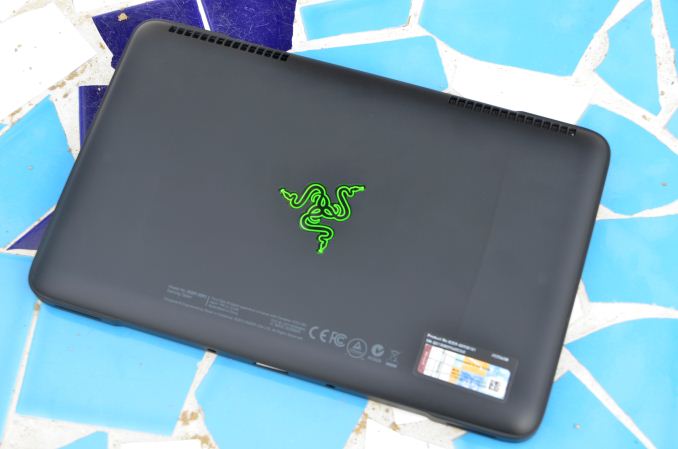The Razer Edge Review
by Vivek Gowri on March 28, 2013 11:00 AM EST- Posted in
- Tablets
- Mobile
- Razer
- Razer Edge
Design
The Edge will be pretty familiar to anyone who has seen or spent any time with Razer systems in the past – consider a tablet with the same design language as the Blade and you’ll be on the right track. Like the Blade that came before it, the design is clean and understated. The matte black anodized aluminum chassis looks actually like a shrunken version of the Blade lid, with the same vertical ridges flanking a glowing green Razer logo. The edges are all radiused, with two large vents on the right and left sides of the top edge (intake on the left, exhaust on the right). The sides of the tablet are unadorned, while the bottom has the dock/power connector located in the center and a pair of speakers located at the corners. The top edge of the tablet has buttons for power, keyboard, rotation, and volume, as well as a 3.5mm combo jack and a USB 3.0 port accented in the traditional Razer green. The front face is completely clean other than the webcam at the top and the circular Windows button located just under the display.
When you first pick it up, it seems pretty antithetical to the slim ARM-based tablets that we’ve gotten used to over the last few years. Even Intel-based tablets like Surface Pro have tried really hard to reach that level of thinness, but the Edge practically flaunts its chunky design. The thickness isn’t the problem I thought it would be going into the review, because quite honestly, the size doesn’t make it uncomfortable to use. The curved sides make for a good in-hand feel, and the Edge feels more comfortable than Surface Pro does. My biggest issue with Surface Pro is that it felt really heavy, but because the Edge weighs just as much and has a significantly larger chassis, it doesn’t have that same dense feel to it. The ridges on the back also play into the in-hand feel, the subtle curvature acts almost like a grip that helps you hold the tablet. It just has a nice, solid, reassuring feel to it when you pick it up.
Razer made a big deal out of the speakers when I last saw the Edge at CES. Tablet audio has been overlooked for the last few years, though it’s finally starting to get its share of attention. The Edge has enough room in the chassis to pack a pair of surprisingly good stereo speakers. Any time you get solid midrange and any semblance of bass out of a tablet or ultrabook, you should be thrilled – it doesn’t happen very often. The speakers on the Edge are clearly and distinctly louder and more defined than any tablet or ultrabook I’ve spent time with in recent times – iPad (even the mini, which has stereo speakers), Surface Pro, ATIV Smart PC and Smart PC Pro, Zenbook Prime, Aspire S7, you name it. They’re legitimately better than any other prominent device in this class.
I have a couple of nits to pick with the design. The first is the bezel around the display – it’s huge. Tablets tend to have larger bezels than we like on notebooks, and the display edge gestures in Windows 8 also have a role to play here, but there’s something to be said for the elegance of a slim bezel. The Edge has a bezel that’s just over an inch wide all the way around. That’s pretty substantial, even compared to the healthy 0.75” width of the iPad’s bezel. The generous bezel means that you’re never worried about accidentally touching the display, but I’d like to see a display closer in size to Surface’s 10.6” panel in this same size chassis. I’m not sure how feasible it is for a company like Razer to get a somewhat irregularly sized panel, though. I’d also be interested in seeing how much bigger the chassis would need to be to fit an 11.6” display, and I’m sure John Wilson and his team kicked that idea around before settling on the 10.1” panel. It’s clear that the ideal display size for Windows tablets is somewhere between 10.1” and 11.6”, so it’ll be interesting to see if more manufacturers take Microsoft’s lead and start shipping devices later this year with displays in the 10.6”-11.1” range.
The other is the Windows sticker on the back – I think they’d have been better off integrating that into the power brick the way ASUS has been doing with their design-oriented systems for some time now. Perhaps I was spoiled by the sleekness of the Blade’s 120W brick, but in comparison the off-the-shelf Chicony 65W AC adapter is ugly and looks like a cheap touch on an otherwise very polished product. I’d like to see something slimmer, like a downsized version of the Blade adapter, with the product stickers integrated to really complete the clean aesthetic the rest of the device has.














89 Comments
View All Comments
kyuu - Friday, March 29, 2013 - link
Because Razer operates on large profit margins, and judging by the Blade and this thing, I'm pretty sure they don't really have any interest in putting out cheap "me-too" platforms. They're more interested in pushing innovative platforms and don't need or expect to move large volumes of the product.B3an - Friday, March 29, 2013 - link
The Vita isn't a full PC with a real OS and Ultrabook level hardware with a game library anywhere near as big as Windows. Stupid comparison.Jumangi - Friday, March 29, 2013 - link
Lolz, this is designed fist as a portable gaming device even though it makes every compromise you can. its price its stupid high, and it looks plain goofy. This thing is stupid and has no place in the market. It sits right up there with the N-gage in the history of dumb gaming devices.Visual - Friday, March 29, 2013 - link
How can you not include IVB integrated results in the games charts? What is wrong with you? That is the ONLY important test that needs to be done to the Edge - is it worth the cost and added bulk over integrated or is it not...Also, saying Civ V is not playable is ridiculous. You did something wrong in the testing. It was playable on my ancient HP tm2 tablet, and that is worse than even the IVB integrated GPU. With the Edge it should be a ton better.
NeedsAbetterChair - Friday, March 29, 2013 - link
I really do love the idea of this but it is obvious to me I'll have to wait a year of two for this category to mature. The next few years are going to be interesting.Hrel - Friday, March 29, 2013 - link
Once again their first attempt is not viable. At 1000 dollars I'd like to see a higher resolution screen, 1600x900 at least. I realize the gpu can't take it, but you can run games at 720p and you'll be fine. Resolution comes down to screen real estate. I need more than 768 vertical pixels. Especially at $1000!!! Furthermore I agree a 64GB SSD is almost useless. 128 should be the entry point with a 256 and maybe a 380 option. I know they can get 256GB SSD's for 150, probably less if they buy in bulk.The thickness of the screen bezel makes me feel like it belongs in the late 90's/early 2000's. Expand the screen .4 to .6 inches and keep the same chassis with a smaller bezel.
I see no value from the i7 "upgrade" and don't want to be forced into it just to get a reasonably sized SSD.
Hrel - Friday, March 29, 2013 - link
On the controller, maybe try moving ab xy to the back, so they line up with you ring and middle fingers? Not sure how well this would work as I've never used anything like it.Shadowmaster625 - Friday, March 29, 2013 - link
Can they get any more stupid? They just trashed any hope of any future for this brand name. This is way way waaaaay too much money to pay for something that gives you such a small boost compared to a bargain bin AMD A10 notebook. They should have just waited for Richland and made a deal with AMD. They could have gotten about the same gaming performance, with 50% better battery life and $400+ cut from the price tag. They could have brought us something decent without the outrageous price that is going to make most people laugh and never look at this brand again. People commenting on facebook and twitter are just morons. It is easy for people to say they want all these things from a product, but it doesnt mean they are actually going to buy what they claim they want.anubis44 - Friday, March 29, 2013 - link
They should use an AMD Jaguar for this. Only an AMD APU will provide the kind of low power consumption and great GPU performance stuffed into a 15w power envelope. Jaguar's GPU destroys the GT640.Silma - Friday, March 29, 2013 - link
So basically this is a tablet thicker than an Ultrabook, with less i/o ports than an Ultrabook, and overpriced gamepad that make it wider than a 17" gamining laptop, all for the pleasure of playing at 1368 resolution?No thanks I'll keep my Alienware notebook. For gimmicky games at low resolution I have a phone.